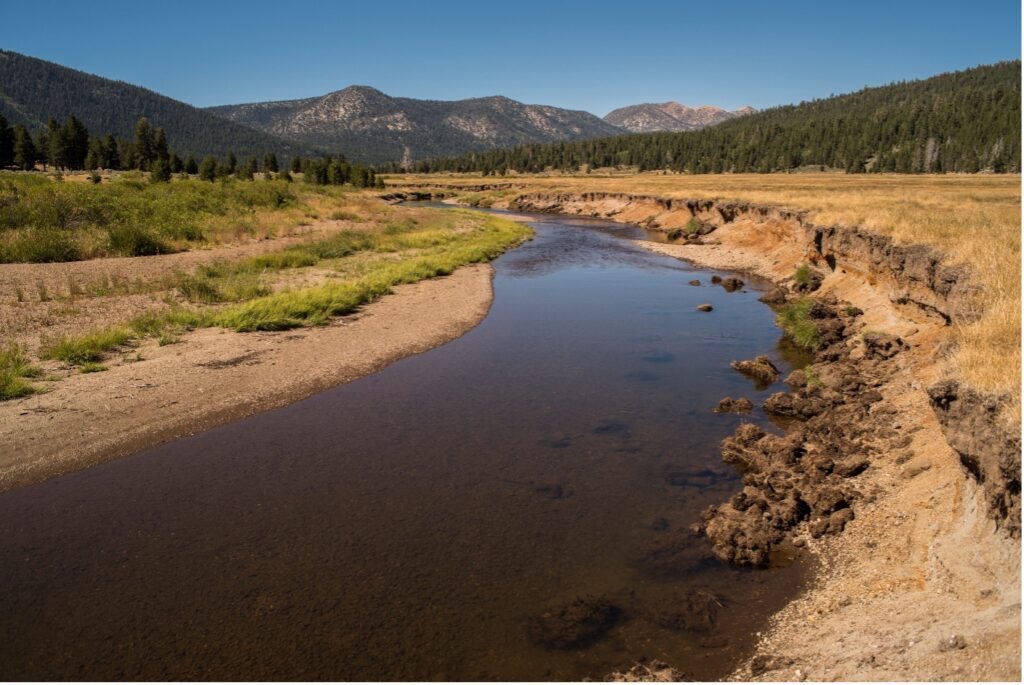Climate change is significantly intensifying drought conditions throughout California, placing the state in an increasingly vulnerable position.
Prolonged periods of reduced precipitation and rising temperatures are depleting critical water resources, jeopardizing the availability of clean water for both residential consumption and agricultural production.
This growing scarcity not only threatens California’s position as a leading agricultural producer but also amplifies the risk of catastrophic wildfires across parched landscapes.
Additionally, the ecological impact is profound—many fish species, particularly those dependent on cold-water habitats, face declining populations, while broader wildlife ecosystems are disrupted.
As the climate crisis deepens, California must confront urgent decisions about water management, conservation strategies, and long-term sustainability to protect its people, economy, and natural environment.
Read More: California’s Drought: 5 Things That Might Surprise You
California’s Drought: A Deepening Crisis with Far-Reaching Impacts
California has always faced periods of drought, but the current crisis is unlike anything seen before.
Climate change is intensifying drought conditions across the state, compromising essential water supplies for homes and agriculture, increasing the frequency and severity of wildfires, and putting immense pressure on fish and wildlife.
A recent study confirmed that California is in the midst of the worst megadrought in 1,200 years—an alarming milestone that underscores the need for urgent action.
Adapting to a Drier Future
Drought may be part of California’s natural climate, but its intensity and frequency are now being supercharged by climate change.
We must act decisively by cutting water use, expanding recycled water programs, replenishing depleted groundwater aquifers, and adopting more sustainable practices for both crop irrigation and municipal use. These measures can build a more resilient and adaptive water system for the decades ahead.
Vulnerable Communities Face the Greatest Burden
California’s small, rural communities—particularly communities of color—are disproportionately affected by water scarcity. During the 2012–2016 drought, at least 2,600 well-dependent households faced severe water shortages, and 150 small water systems required emergency aid (Public Policy Institute of California).
As water tables continue to fall due to over-pumping, extreme heat, and lack of rainfall, these communities remain at high risk.
To ensure long-term water security, we must invest in infrastructure that connects small systems with larger municipal supplies and restore groundwater by capturing high flows for recharge.
Drought’s Impact on Fish and Wildlife
The state’s rivers, wetlands, and streams are vital habitats for over 240 freshwater species, many of which are endangered. Reduced stream flows and rising water temperatures threaten species such as salmon, which rely on cold-water streams to reproduce.
Unfortunately, warm releases from reservoirs and the loss of shaded riverbanks are destroying these crucial spawning grounds.
Protecting biodiversity requires bold strategies: securing environmental water rights, collecting better flow data to guide decisions, and restoring access to cold-water tributaries like the Feather, Yuba, and Sacramento Rivers.
The Dangerous Wildfire-Drought Feedback Loop
While it’s clear that drought increases wildfire risk, it’s less understood how wildfires can worsen drought. When intense fires devastate Sierra Nevada forests, they eliminate vegetation that would typically absorb and retain rain or snowmelt.
The result is increased erosion and runoff, which sends sediment and pollutants into rivers and reservoirs, degrading water quality and reducing supply during critical dry months.Forest thinning, prescribed burning, and Indigenous cultural fire practices can significantly reduce these risks.
Research shows prevention costs only one-third of post-fire recovery expenses.
Restoration Offers Multi-Benefit Solutions
Nature-based solutions are essential for navigating this crisis. Multi-benefit restoration projects—such as meadow restoration in the Sierra Nevada and floodplain reconnection in the Central Valley—enhance water storage, improve quality, restore ecosystems, and mitigate flooding.
American Rivers and other organizations are leading the way, proving that ecological health and water resilience go hand in hand.
Get Involved: Your Local River Needs You
Healthy rivers are foundational to California’s water future. Connect with your local watershed and support organizations dedicated to sustainable water solutions. For resources on drinking water, drought preparedness, and community impacts.
Frequently Asked Questions (FAQs)
Why is California experiencing such intense droughts?
California’s droughts are becoming more severe due to the effects of climate change, including rising temperatures, reduced snowpack, earlier snowmelt, and more erratic precipitation. These factors combine to reduce water availability and strain both natural ecosystems and human water systems.
How does drought affect drinking water supplies?
Drought reduces the amount of surface water in reservoirs and rivers, and it depletes groundwater aquifers, which many rural communities rely on. In some areas, wells go dry entirely, leaving households without access to safe drinking water.
What communities are most at risk?
Small, rural communities of color are often the most vulnerable. Limited infrastructure, financial resources, and dependence on shallow or private wells make these communities highly susceptible to drought impacts.
How does drought affect wildlife and fish?
Drought reduces streamflow and increases water temperatures, which threaten cold-water species like salmon and steelhead. Reduced habitat, pollution from runoff, and the loss of shaded areas along rivers further exacerbate the risk to biodiversity.
Can wildfires make droughts worse?
Yes. Severe wildfires damage forests that help store and filter water. Without vegetation, rainfall runs off quickly, leading to erosion, sedimentation in water systems, and reduced water retention in soil and snowpacks.
What are multi-benefit restoration projects?
These are nature-based solutions that address multiple challenges at once—such as restoring meadows or reconnecting floodplains—to improve water quality and storage, protect wildlife, reduce flood risk, and enhance climate resilience.
Conclusion
California’s drought is no longer a seasonal inconvenience—it’s a persistent, intensifying crisis fueled by climate change. From dwindling drinking water supplies and vanishing salmon habitats to catastrophic wildfires and struggling rural communities, the impacts are deep and far-reaching. But we are not powerless.

